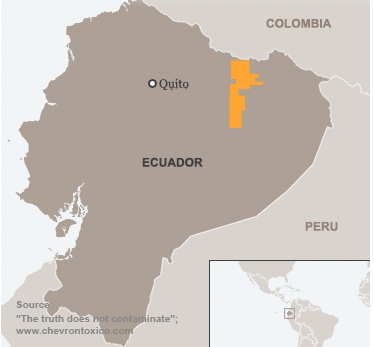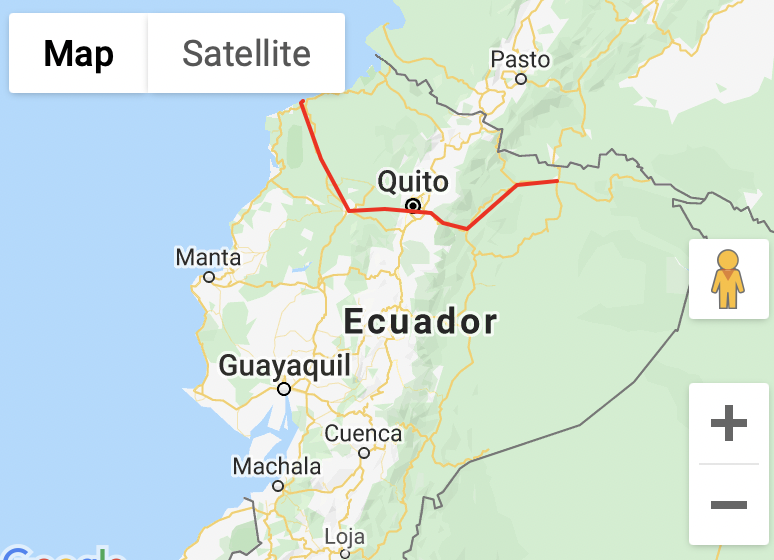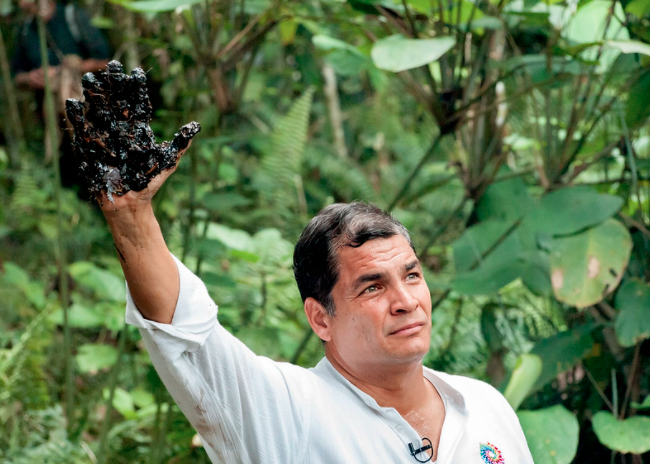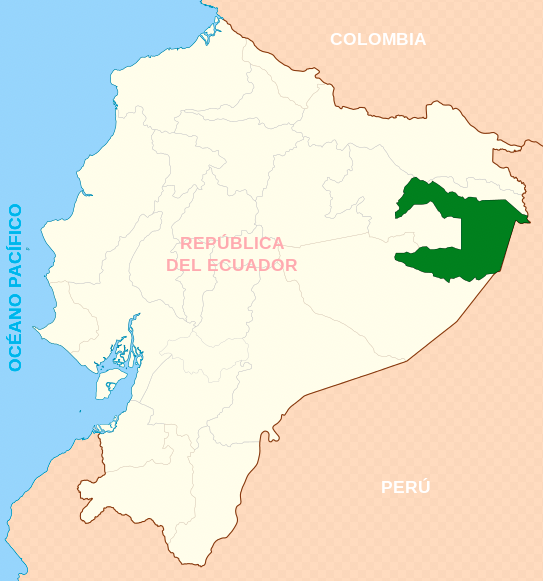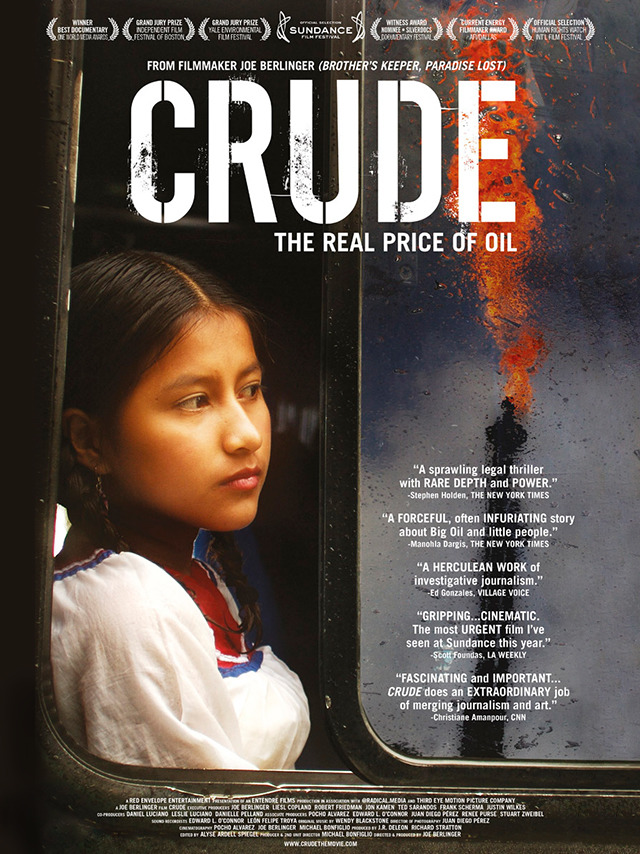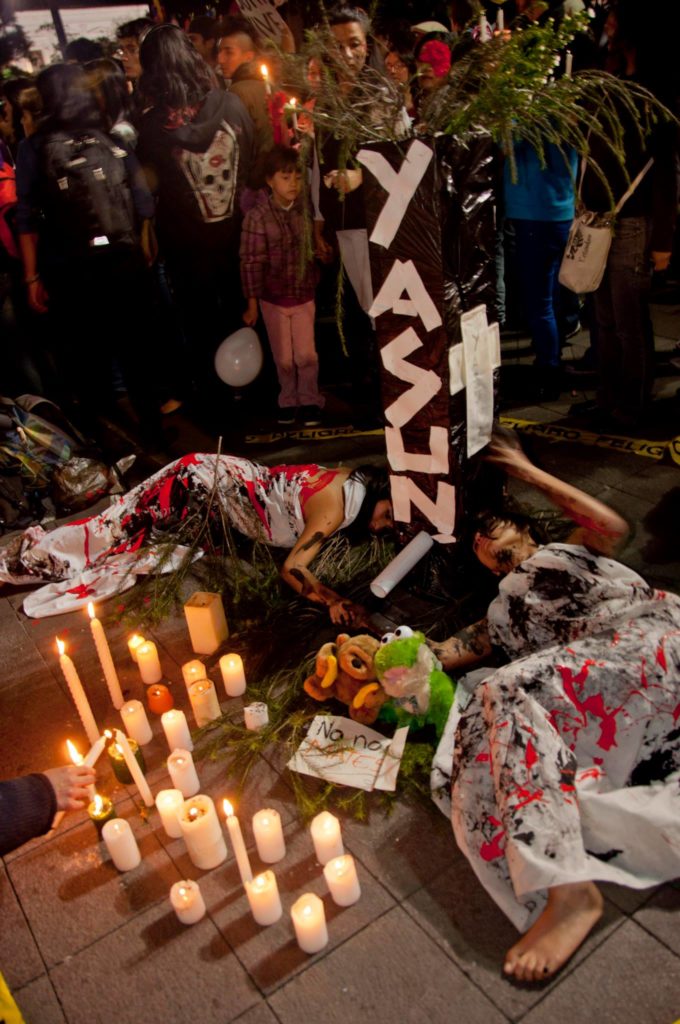1911
Beginning of Oil Explotation in Ecuador
First Equipment to drill soil arrives in Ecuador
In the same year, the first oil well called Ancon 1 was discovered in Santa Elena.
1960
Oil as the hope of modernization
Texaco enters Ecuadorian soil
-
- Texaco was given around about 1,500,000 hectares of the Ecuadorian Rainforest located in the city of Nueva Loja in the province of Sucumbíos, western Basin of Ecuador, right at the border with Colombia.
- Until 1950 Ecuador relied on the export of Bananas. With the discovery of oil reserves the Ecuadorian economy switched from an agrarian to an oil exporting one and quickly Oil became the hope for modernization and a card out from the “ underdevelopment”.
- Image:https://www.dw.com/en/a-slippery-decision-chevron-oil-pollution-in-ecuador/a-18697563 Retrieved: 10.08.2021
1972
Commercial export of Crude Oil began
The SOTE Oil Pipeline or Trans-Ecuadorian Pipeline System is finished
The 498 km main pipeline was built to transport oil from the Amazon region across the Andes Mountains to the Pacific coast, additionally around thousand kilometers of secondary pipelines, and finally to transport the workers and other services also paved roads were necessary. During the construction of the pipelines and roads, deforestation of this fragile ecosystem is inevitable.
1989
First Documentation of Oil Impacts in the Rainforest
Judith Kimerling
- Judith Kimerling a graduate of Yale Law School and former New York State assistant attorney general travels to Ecuador to work with Indigenous Organizations who helped her document for the first time the impact of Oil production on the communities and the environment.
Texaco transfers operational responsability
Texaco transferred operational responsibility for exploration and production to a subsidiary of Petroecuador. Nevertheless, Texaco maintained a limited ownership in the consortium until its contract with Ecuador expired in June 1992
On this year Judith Kimerling extends her calculations and conclusions on Texaco’s operation to the Ecuadorian officials. They were perplexed by all the environmental processes they have never seen before. Afterall Texaco was a kind of teacher for them, except they never taught them what happens after drilling oil.
[1]
[1] Kimerling, „Lessons from the Chevron Ecuador Litigation“, 249.1993
"The Amazonian Trial of the Century"
Aguinda v. Texaco, Inc.
A group of 30,000 Ecuadorian indigenous peoples and farmers living in the vicinity of the contaminated sites filed a class-action lawsuit against the U.S company Texaco, Inc*
The research documented by Judith Kimerling since her first visit in 1989 was the basis for the environmental lawsuit filled for the first time in a New York Court
Although Chevron-Texaco was freed from its contract with the government, the pollution caused to the indigenous people was still visible. The plaintifs seek a payment of almost $19 billion to clean up the area and provide health care and clean drinking water.
*Chevron inherited the lawsuit in 2001 after merging with Texaco
1998
Non-compliance Act and remediation Program
President Jamil Mahuad signs the “ Acta Final”
The non-compliance Act was signed after a quick cleanup program in the rainforest, thus released Texaco from all obligations with the State. The remediation program was controversial due to limited coverage and lack of transparency. Eyewitnesses reported the company had just dig pits and filled them up with toxic waste and then proceeded to covered the surface of oil pools with only dirt. This hazardous material penetrated the soil and eventually reached rivers and all water supply.
Feb 1999
Indigenous peoples are granted a conservation area
Decree 552 the “Intangible Zones”
- Through the Decree 552 the “Intangible Zones” is declared a conservation area. All types of extractive activities are prohibited in the lands where the uncontacted Indigenous Groups Tagaeri and Taromenane peoples are located while traditional activities such as hunting, fishing, and traditional use of biodiversity is allowed.[1]
[1] Pappalardo, De Marchi, und Ferrarese, „Uncontacted Waorani in the Yasuní Biosphere Reserve“, 5.
The Tagaeri and Taromenane People decided voluntarily to stay in isolation in the Amazon rainforest. After seeing the damaged caused by the exploitation of natural resources and large-scale deforestation in the zone by Texaco, the Ecuadorian government compromised to guarantee the survival of these groups.
May 2003
New Lawsuit against Chevron in Ecuador
Case presented to an Ecuadorian Court
Almost a decade has passed since the first lawsuit was presented in the U.S, yet Chevron sought for court dismissal of the case and insisted to be taken to Ecuadorian courts because most of the evidence and witness are there. Therefore in May 2003 a new Lawsuit was presented against Chevron in Lago Agrio Ecuador, where Texaco operated for more than 2 decades.[1]
[1] Kimerling, „Lessons from the Chevron Ecuador Litigation“, 244. Jan 2007
A new hope for the case
Left-wing Economist Rafael Correa becomes President of Ecuador
The new president meant a new hope for the trial because he has identified himself as a humanist and a progressivist that aims to represent the interests of the ordinary people.
April 2007
President Correa witness the contamination in the rainforest
President Correa visits a contaminated Pit operated by Texaco
President Correa visits a contaminated Pit operated by Texaco to witness Texaco pollution in the homelands of farmers and indigenous people.
September of the same year Rafael Correa launched a campaign “Chevron’s Dirty Hand” which condemns Chevron for its evasion of responsibilities with the people, the environment, and calls for an international boycott of the company.
Other international figures visited the jungle to witness the disaster and drenched their hands in the oil pools in the middle of pristine rainforests. Among them Richmond Mayor Gayle McLaughlin the only Green party mayor of the city of Richmond, the actress Mia Farrow, Jean-Luc Melenchon a French politician, actor Danny Glover. All of them took a similar photograph to the President and where part of the campaign against Chevron.
Brad Pitt and Angelina Jolie known for their humanitarian work commitment also inspected the contamination in 2012
Image:https://www.pressenza.com/de/2014/08/die-schmutzigen-hande-des-olmultis-chevron-texaco-interview-mit-jorge-jurado-botschafter-ecuadors-berlin/ Retrieved: 23.08.2021
Aug 2007
Initiative Yasuní-ITT
“ Sumak kawsay” or Collective well being
Image: Zone to be protected under the Yasuni-ITT plan
The government of Rafael Correa launched the Yasuní-ITT Initiative based on the philosophy of the “
Sumak kawsay” living well
The sociologist Catherine Walsch denotes the
buen vivir, as a system of knowledge and living based on the communion of humans and nature.
[1]The Yasuní-ITT Initiative was an innovative development proposal about cease of planning oil extraction in the Yasuni National Park, in exchange for international monetary compensation. President Rafael Correa established a fund where he plead the world community to contribute 50 percent of the earnings drilling the rainforest had brought to the country. For the international community it meant a contribution to deforestation avoiding pollution and conservation of such a biodiverse ecosystem also called ”the lungs of the earth” due to the amount of oxygen it provides for the planet,
[2]
[1] Walsh, „Development as Buen Vivir“, 17.
Source: https://commons.wikimedia.org/wiki/File:Localizaci%C3%B3n_de_Yasun%C3%AD_en_Ecuador.svg retrieved: 20.07.2021 Ecuador passes a new environmental law
- Ecuador passes a new environmental law in the constitution giving nature or “Pachamama” ( in Kichwa language) and ecosystems rights. [1]
This government takes a step forward towards environmental consciousness. Not only it recognizes nature as a living being and guarantees to fully respect its existence, but assures the right of the population to live in a ecologically balanced environment.
[1] CONSTITUCIÓN DE LA REPÚBLICA DEL ECUADOR 2008, S. art. 71-74.Jan 2009
Release of an American documentary Film
Controversial Documentary
Release of the documentary film directed and produced by Joe Berlinger. The film follows the main actors through the class action lawsuit against Chevron.
Defendants of Chevron claimed the film showed bravery and corruption from the plaintiff’s legal team therefore through a Court order the film producer needs to turn over more than 600 hours of footage.
[1]
[1] Hurley, „U.S. Top Court Hands Chevron Victory in Ecuador Pollution Case“.
Image: https://www.imdb.com/title/tt1326204/ retrieved on 20.08.20212011
A victory after another 9 years
Ecuador Supreme Court ruled against Texaco-Chevron
- Ecuador Supreme Court ruled that Texaco-Chevron owed $9.5 billion (equivalent at the time) in compensation for dumping more than 18 billion gallons (68 billion liters) of oil and toxic waste in the Ecuadorian Amazonia region
Chevron does not own any assets in Ecuadorian soil ( left in 1992) therefore plaintiffs seek to enforce the judgment where Chevron currently has operations. For example: Canada, Brazil or Argentina. Their next step is to pursue Chevrons assets in Canada, where Chevron owns still around $15 billion in assets.
New York court rules the Ecuadorian trial as invalid
Judge Lewis A. Kaplan claims that during the trial, Ecuadorian lawyers committed corruption, bribery, submitted false evidence among others therefore its declared as invalid.
August 2013
President Correa calls off the Yasuni-ITT plan.
"The world has failed Ecuador"
The government of Ecuador cancels the Yasuni-itt initiative and liquids the trustfund. “The world had failed Ecuador”.
[1] Ecuador had hoped to raise around $100 million dollars but after almost six years, the fund had raised only $13 million.
This shocked the population and sparked many student protests along with indigenous social movements through the country. Nevertheless extraction was permitted in the Yasuni in 2014 and operations started in 2016.
[2]
[1] „Correa “.
[2] „Ecuador Approves Yasuni National Park Oil Drilling in Amazon Rainforest“.
Image: Pacific student protests in Quito-2013 Source: Andrango, Carla 2013, Quito
International tribunal in The Hague in the Netherlands
The District Court of The Hague ruled in favor of Chevron Corporation and decided the Judgement by the Ecuadorian Supreme Court against Chevron happened only through corrupt means and the nation violated its obligations under international treaties.
[1]
[1] Krauss, „Dutch Tribunal Upholds Chevron’s Award Against Ecuador“.